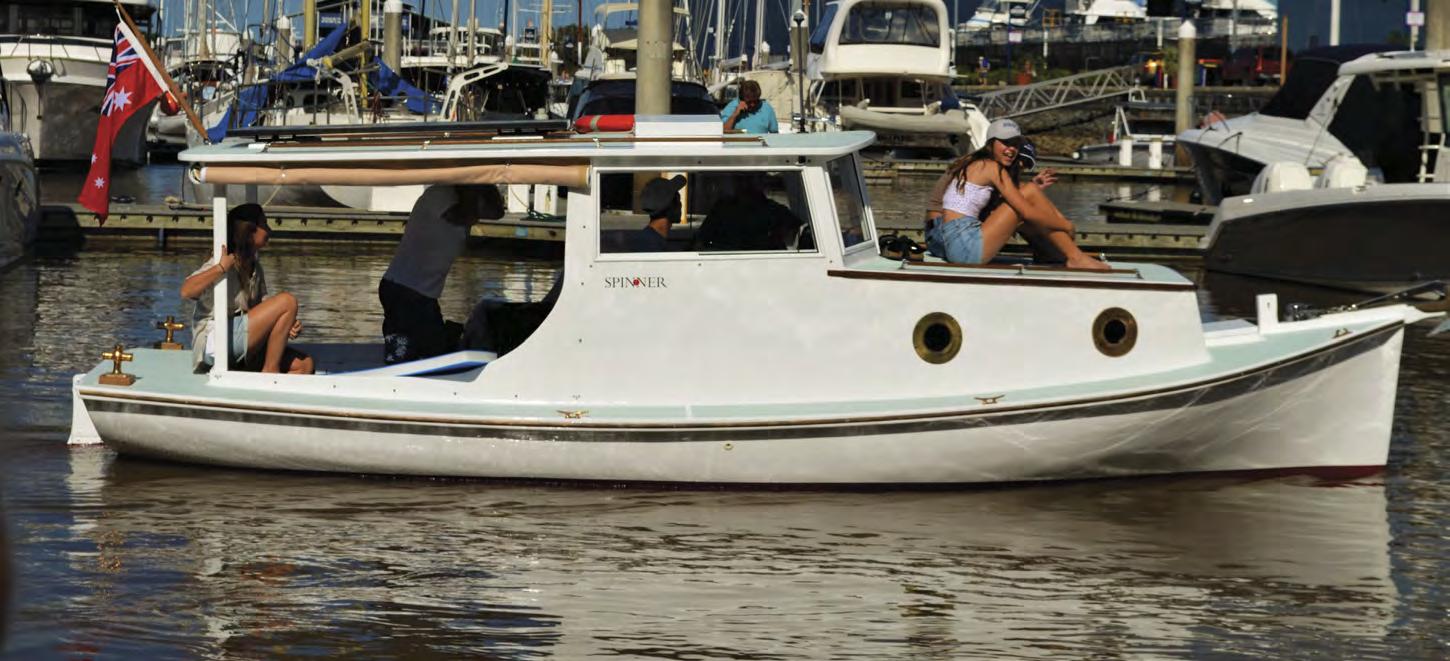
4 minute read
Restoring "Spinner"
Spinner RESTORING A 101-YEAR-OLD BEAUTY By Angus Thomson
As readers may recall from a 2019 article written by Chris Logan, Shodai Shintani, with limited English at the time, migrated to Australia from Japan. He had a burning ambition to work with timber and, after a brief flirtation with carpentry, stumbled across the boatbuilding industry at Regatta Marine, which specialises in classic boat restorations among a broad range of other services. Working at Regatta Marine under the mentorship of Doug Fielding, Regatta Marine’s director, Sho (as he likes to be called) honed his boatbuilding skills and produced his first classic boat, a labour of love, the 10-foot Hinata.

Fast forward to 2020. Sho’s mentor, Doug Fielding, is scrolling through boating advertisements on Gumtree and finds the 101-year-old wooden boat, Spinner, for sale. The antique vessel needed restoration, and Doug immediately thought of Sho who had made known his desire to restore an old wooden boat. This boat certainly fit the description. Was Sho interested? He certainly was! However, the $3000 price tag was too much for Sho at the time. Then, in a strange quirk of fate, Sho’s car was recalled for an airbag problem, and the car manufacturer bought the car from Sho for exactly $3000. He could not believe his good fortune. So it was that Sho became the proud third owner of a 20-foot wooden boat, the previous owner having possessed Spinner for 82 years! Now realizing that his dream of restoring a historic, wooden boat was becoming a reality, the problem of transporting the 101-year-old boat over 800 kilometres, from the other side of Sydney to his shed on the Gold Coast, started looming large in the back of his mind. After Sho raised the concern with him, Doug jokingly asked a friend who was down in Sydney on a game boat, if they could tow the 20-foot wooden beast home. To his surprise, the friend agreed. Sho flew to Sydney to prepare the boat, which had not been used for years, for the 50-kilometre trip down the Parramatta River to meet the game boat. However, in a run of bad luck, the game boat broke down before reaching port, yet Sho only received the message halfway into his trip down Sydney’s busy Parramatta River. When he got news of the breakdown, Sho decided that the best course of action was to go back to where he first started. Unfortunately, the journey back was not as simple as expected. In the middle of the river, the engine suddenly stopped. Faced with the prospect of drifting, with no engine and no paddles, among the busy ferry lanes of the Parramatta River, Sho was freaking out and contemplating swimming for shore, when his luck changed for the better. By sheer chance, and somewhat ironically, his boat had broken down facing a speed sign. He was able to drift close enough to leap across to the signpost and tie the boat up. No longer drifting, Sho set about trying to fix the engine. Realizing that the problem was electrical, he decided to call his mentor for advice on rewiring the 101-year-old boat. However, when he heard the sad tale, instead of reassuring words and advice, Doug cracked up laughing. Fortunately, he recovered enough to help Sho rewire the boat over the phone, so he could continue his journey. When Sho arrived back to where he started, he received news that the Queensland borders were closing in a matter of hours. With no way home, he again called Doug to ask for advice. Doug informed him that the game boat had just completed repairs to its engine and was ready to return to Queensland waters. He advised Sho to catch an Uber to the game boat and try to get home before they were all stranded in New South Wales.

Sailing non-stop, with the crew working shifts around the clock, and with barely an hour to spare till lockdown, Sho caught his, and the boat’s, first black marlin, just as they crossed the border. “We didn’t get my boat home, but it was a hell of a trip,” recalls Sho. “After all of that effort and trouble, we still weren’t able to get the boat home, but it makes a cracking story,” adds Doug. So how did they get the boat home? They eventually had the boat freighted up to the Gold Coast, costing Sho a good portion of his savings. Then, for 11 months, 7 days a week, 10 hours a day, Sho worked on Spinner to bring it to life, to create a home on the water for himself, and to restore a part of history.

Spinner on the journey to the Bribie Classic Boat Regatta
“No Christmas, no holidays,” Sho stated, regarding the amount of effort, passion, and time he put into restoring Spinner. However, it was not just Sho who worked on Spinner: an entire community came together to restore this part of history. The boatbuilding community was inspired by Sho and his story and wanted to help. Everything from the 50-year-old steering wheel to the flares was donated. The community even helped with the wiring and propeller. “I couldn’t have built this boat without everyone involved,” said Sho. When asked if he had any more boatbuilding plans, Sho replied: “I’ll never stop building boats; a boat is never finished. I can’t wait to start another project.”










